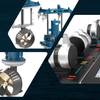The current basic family of MAN B&W's large medium-speed diesel engines consists of four sizes L 58/64, L/V 48/60, L 40/54 and L/V 32/40, launched between 1985 and 1995. This engine family covers an output range from 2,880 kW (6L 32/40) to 18,900 kW (18V 48/60). Within the last few years, this portfolio has been supplemented by the V 40/50, the smaller engine sizes L 16/24 and L 27/38, and, finally, the new L 21/31 (2002/03). All engines are fully heavy fuel oil compatible and have been optimized for both high fuel economy and lowest exhaust gas emissions.
In terms of sold power, the 48/60 engine is second in the list of MAN B&W's bestsellers. Since its market launch in 1989 to January 31, 2002, a total of 245 engines of this size, representing 3.7 million hp, has been sold, of which 162 engines were for marine applications
The 48/60 has evolved with the needs of the market in its 13 years. Service experience and improvement in component design are just two reasons driving change. In addition, progress is made in better understanding injection, combustion and emission control. Both theoretical and experimental development work result in greater insights into the many processes involved, allow safe prediction of component loadings, safety levels and even lifetimes. With all this experience and knowledge at hand, it is possible today to upgrade an existing proven engine in regards of output, fuel consumption, emissions, and component safety, whilst retaining proven engine sub-groups.
For these reasons MAN B&W decided to retain the main dimensions, bore and stroke, of the 48/60 and with it many proven engine subgroups, while modifying and changing a variety of other key engine components.
The new engine is named 48/60B, with a rating of 1,200 kW per cylinder at 500 and 514 rpm, respectively. This is equal to an increase of 14 percent over the current nominal output of the 48/60 engine.
The 48/60 B also is cleaner and leaner, featuring:
• Increased efficiency (fuel savings, lower carbon dioxide emission)
• Less smoke and nitrogen oxides
• Reduction in engine width and, consequently, in center-to-center distance in order to reduce the gear size
• Improved operational and component reliability
• Increased ease of maintenance
• Reduction in weight-to-power ratio
• Reduction of manufacturing costs by applying improved design features and a lower number of engine components and parts.
Achieving Better Fuel Economy
With a bore of 480 mm and a stroke of 600 mm (bore-to-stroke ratio = 1.25), the 48/60B engine obviously is not a typical long-stroke engine with its options to reduce fuel consumption rates. However, even with the same bore-to-stroke ratio, the bundle of in-engine measures effected gave the same result — at a lower cost. A package of engine-internal measures was worked out, initially confirmed to be feasible by simulation calculations and finally tested step by step on a 12V 48/60B protopype engine in order to find the best solution between several variables, i.e. an acceptable compromise between fuel consumption, component loading, and NOx and smoke emissions.
To achieve this target, the following principal correlations, which are partly in conflict with each other, had to be considered and the work process was modified accordingly:
1. Adoption of a "slight" Miller process to lower combustion temperature levels, and, with them, NOx emission.
2. Increase in injection intensity for lower soot production and therefore lower smoke emissions, especially at partload. Unfortunately, this measure has a negative effect on NOx emission. In order to neutralise the increase in NOx emission, the injection can be retarded, although this leads to a higher fuel con-sumption rate and increased particle emission.
3. To neutralize the fuel consumption disadvantage resulting from step (2), it is necessary to take advantage of the firing pressure potential of the engine. Therefore a higher compression ratio has been chosen for the 48/60B.
4. Use of the considerably increased efficiency level of the newly-designed MAN B&W TCA-type turbocharger so that the resultant fuel savings from steps (1) to (3) exceeded the fuel losses involved in (1) to (3).
By optimizing the combustion space geometry (with unchanged engine stroke), which was achieved by avoiding dead volumes, edges and ribs in the combustion side of the cylinder cover, the compression ratio was increased from e = 14.4 (48/60) to e = 15.3 (48/60B). A possible further increase in e would most likely result in increased smoke emission at low loads. A conventional medium-speed diesel engine with a bore-to-stroke ratio of 1.25 and a rather high compression ratio of, for instance e = 17, would produce a pronounced dark plume — even at higher engine loads - which would be visible from far away.
The slightly increased compression ratio of the 48/60B has another beneficial effect: it improves the ignition behaviour of lowest-quality heavy fuel oils. The 48/60B can there-fore safely operate with HFO up to a viscosity of 700 cSt/50°C and runs on fuels up to, and including, the CIMAC H55/K55 specifications.
The firing pressure of the 48/60B was increased to a maximum of 200 bar. This, in con-nection with other measures such as modified injection (the injection pressure was in-creased from 1,300 bar for the 48/60 to 1,600 bar) and a further improved gas exchange process, resulted in a process very close to the ideal constant-pressure combustion. The higher firing pressure was possible without risking the operational safety of the engine: to have the same safety margins as the 48/60 in spite of a higher mechanical loading, better materials were used and/or components strengthened.
Sponsored Content
Chris-Marine’s solutions help to prolong engine lifetime

Subscribe for
Maritime Reporter E-News
Maritime Reporter E-News is the maritime industry's largest circulation and most authoritative ENews Service, delivered to your Email five times per week










